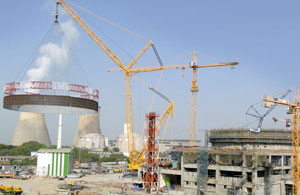
Implementation of PRL at KAPP-3
The 700 MWe Indian pressurised heavy-water reactors (PHWRs) that are being constructed at the Kakrapar Atomic Power Project (KAPP) 3 and 4, and RAPP 7 and 8 have a number of firsts design features towards enhancement of safety. The steel liner on inner containment (IC) wall of about 50 m dia encasing reactor building is being one of them. The liner of 6 mm thick is provided for better leak tightness. The IC wall is 48 m height from the raft level to the ring beam bottom level.
The steel liner erection scheme initially used 16 liner panels of 10 m (circular length) x 5 m (height) and weighing 5.5 tonne each. These panels consist of liner plate, backing trusses and stiffeners (vertical and circumferential). Each such panel is fabricated at fabrication yard and erected by tower crane in position at the inner periphery of the IC structure one by one. After keeping all the panels and adjusting their positions, fit up, tack welding and final welding is done. This process of aligning and welding of adjacent panels becomes more and more difficult at higher elevations.
Based upon the availability of high capacity crawler crane (LR11350) and international experience in modularisation of containment liner, the feasibility of construction by preformed ring liner (PRL) was pursued, ie, assembling 16 IC liner panels at ground and erecting the same as a ring.
These studies also established that significant savings in steel could be affected by elimination of backing trusses required for the individual panels.
The advantages of adopting this new technique are:The seventh ring of KAPP-3 was successfully installed for the first time on 31 December 2013, and would count as the largest (dimensionally) engineered structures to have been lifted and placed in such a manner in India. This effort epitomises the team work and spirit of the Indian nuclear industry.
Salient Features

 +91-22-24193000
+91-22-24193000 Subscriber@ASAPPinfoGlobal.com
Subscriber@ASAPPinfoGlobal.com